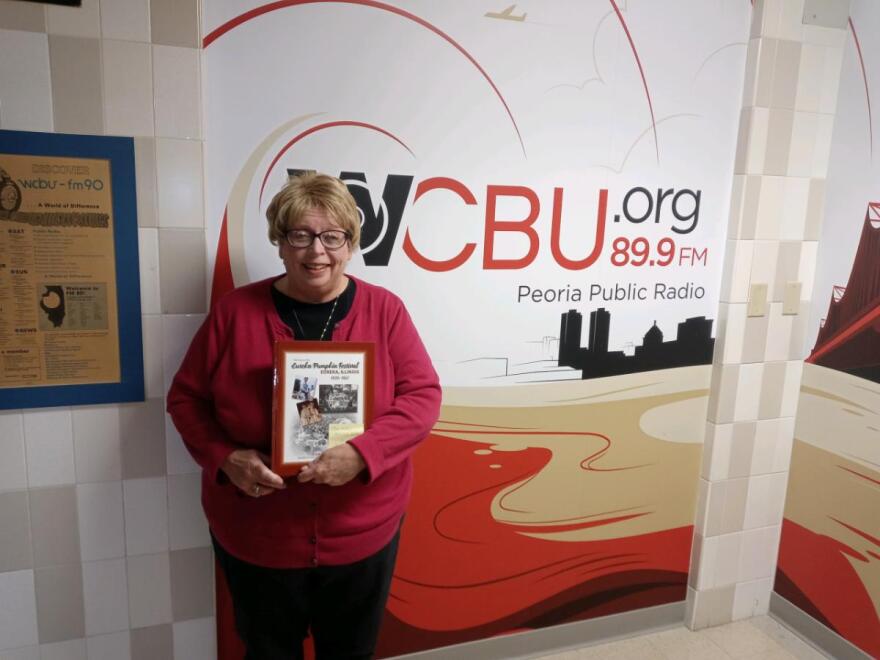Morton is synonymous with pumpkins.
About 85% of the world's canned pumpkin product is produced at the village's Libby's plant. Morton celebrates its signature crop with the annual Morton Pumpkin Festival each fall.
Yet the Tazewell County community of just over 16,000 people wasn't the first "Pumpkin Capital of the World," or the first home of the Pumpkin Festival. That honor belongs to Eureka, the Woodford County seat, about 17 miles northeast of Morton.

Beth Harms Miller, the newly installed president of the Woodford County Historical Society, only became aware of the Eureka Pumpkin Festival while doing research for an article in the society's newsletter.
"I always kept wondering why we had all this Pumpkin Festival stuff there. And I always thought Morton was the Pumpkin Festival," Miller said.
That article sparked an idea for a book. Miller recently released The History of the Eureka Pumpkin Festival through the not-for-profit Woodford County Historical Society.
Miller did much of her research with the historical society's archival materials, and by digging through old editions of the Woodford County Journal, Peoria Journal Star, and Bloomington Pantagraph, but other papers like the Washburn Herald, and even Chicago publications also covered the festival's events.
Miller said the Eureka Pumpkin Festival's roots lie in the Dickinson family cannery, founded in Eureka in 1885. The family was the namesake of the Dickinson pumpkin grown widely throughout Illinois today.
In 1902, the Dickinsons began canning pumpkin products. The plant was later sold to Libby's in 1929.
The festival began ten years later as an initiative of the Eureka Community Association. Miller said she's not quite sure what inspired the idea, but she does know it took about two and a half months to put together in 1939, at a cost of $674, or about $12,000 in today's money when adjusted for inflation.
"It was started out as a two day celebration. And you start on Friday, sometime Friday afternoon. They'd have opening ceremonies in the courthouse square," she said. "The local radio channels were all there broadcasting some of that. They had free entertainment on stage there by the courthouse."
Pie baking contests, pie eating contests, and a carnival were other highlights. Miller said much of the entertainment was free, so people didn't have to dig too deep into their pockets to enjoy the festival.

One of the most memorable festivals came in 1947, when Eureka College alumnus, movie star, and future U.S. president Ronald Reagan came to town to attend the festival.
"He paid his own way to Eureka (and) came on the train. And they picked him up in Chillicothe, and a big caravan of cars came back to Eureka. So it was just a wonderful, wonderful event for everyone," Miller said.
Through social media, Miller was able to track down a woman who was 11 years old when Ronald Reagan boarded at her grandmother's house during the festival. She said the house was only approved for Reagan's stay after scouts sent out from Warner Brothers deemed it an acceptable accommodation.
A letter records more details about Reagan's 1947 visit to Eureka.
"After they'd been on their daytime adventures, he'd come back. And him and most a lot of the guys that were with them were former classmates of his," Miller said. "And he just talked about Hollywood life, and just how Eureka was so important to him. And it made him who he was. He talked about it."
Reagan decided he wanted to help raise funds for building projects in the town, so he turned a high school football game into a regional event by offering to do the play-by-play for WJBC-AM.
Additional bleachers were brought out as people from all across Illinois were drawn out to the game, Miller said.
The cannery uprooted for Morton in 1960, but the city's Community Association decided to continue with the festival tradition the following year. It was to be the last.
"It was like a really sad season that year. It was raining. And so there's very, very few pictures I could find from this festival, even though it was the last one and everybody had cameras," Miller said.
At its height, nearly each of Eureka's 1,700 residents had a role to play in setting up the Pumpkin Festival, whether it was setting up, cleaning up, or making their lawns available for parking.
Visit the Woodford County Historical Society's Facebook page for more information about Miller's book, The History of the Eureka Pumpkin Festival.


